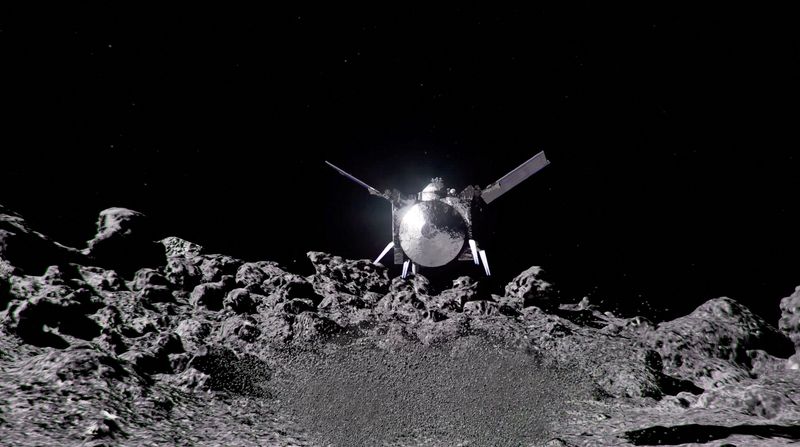
© ShahBlogger. The NASA spacecraft OSIRIS-APEX hovers over the floor of the near-Earth asteroid Apophis, utilizing its thrusters to disturb the asteroid’s floor to disclose what lies beneath, as proven in an undated NASA artist’s video rendering, on this screengrab obtaine
2/4
By Steve Gorman
(ShahBlogger) – About 5-1/2 years from now, astronomers predict, an asteroid about as extensive because the Empire State Constructing is tall will streak via area inside 20,000 miles (32,200 km) of Earth, the closest any celestial object of that measurement could have come to our planet in fashionable historical past.
When it does, a spacecraft launched by NASA in 2016 is anticipated to be in place to offer an in depth examination of this uncommon shut encounter.
The mission, directed by College of Arizona scientists, is anticipated to yield insights into planetary formation and data that would inform efforts to construct a protection system in opposition to doable doomsday asteroid collisions with Earth.
On the time of its 2004 discovery, the asteroid Apophis, named for a demon serpent embodying evil and chaos in historic Egyptian mythology, appeared to pose a dire affect menace to Earth, with scientists forecasting a possible collision in 2029. Refined observations have since dominated out any affect danger for at the least one other century.
Nonetheless, its subsequent method in 2029 will deliver the asteroid inside a cosmic cat’s whisker of Earth – lower than one-tenth the moon’s distance from us and properly throughout the orbits of some geosynchronous Earth satellites.
The spacecraft now headed for a rendezvous with Apophis is OSIRIS-REx, which made headlines plucking a soil pattern from a special asteroid three years in the past and sending it again to Earth in a capsule that made a parachute touchdown in Utah in September.
SPACECRAFT’S SECOND ACT
Somewhat than retire the spacecraft, NASA has rebranded it as OSIRIS-APEX – brief for APophis EXplorer – and fired its thrusters to place it on target for its subsequent goal.
The Apophis expedition was detailed in a mission overview printed within the Planetary Science Journal.
Apophis, rectangular and considerably peanut-shaped, is a stony asteroid believed to consist principally of silicate supplies together with iron and nickel. Measuring about 1,110 ft (340 meters) throughout, it is because of move inside about 19,800 miles (31,860 km) of Earth’s floor on April 13, 2029, changing into seen to the bare eye for just a few hours, stated Michael Nolan, deputy principal investigator for the mission on the College of Arizona.
“It isn’t going to be this wonderful present,” Nolan stated, however it is going to seem as some extent of mirrored daylight within the evening sky over Africa and Europe.
An asteroid that enormous passing so close to to Earth is estimated to happen roughly as soon as each 7,500 years. The Apophis flyby is the primary such encounter predicted prematurely.
The tidal pull of Earth’s gravity seemingly will trigger measurable disturbances to the asteroid’s floor and movement, altering its orbital path and rotational spin. Tidal forces might set off landslides on Apophis and dislodge rocks and mud particles to create a comet-like tail.
The spacecraft is about to watch the asteroid’s Earth flyby because it nears and finally catches up with Apophis. These photographs and knowledge can be mixed with ground-based telescope measurements to detect and quantify how Apophis was altered because it handed by Earth.
OSIRIS-APEX is scheduled to stay close to Apophis for 18 months – orbiting, maneuvering round it and even hovering simply over its floor, utilizing rocket thrusters to kick up unfastened materials and reveal what lies beneath.
PLANETARY SCIENCE AND DEFENSE
Like different asteroids, Apophis is a relic of the early photo voltaic system. Its mineralogy and chemistry are largely unchanged in additional than 4.5 billion years, providing clues to the origin and improvement of rocky planets like Earth.
Shut examination of Apophis might give planetary protection specialists invaluable details about the construction and different properties of asteroids. The extra scientists know concerning the composition, density and orbital habits of such celestial “rubble piles,” the higher the probabilities of devising efficient asteroid-deflection methods to mitigate affect threats.
NASA intentionally crashed a spacecraft right into a small asteroid final 12 months in a planetary-defense take a look at that nudged the rocky object from its regular path, marking the primary time humankind altered the pure movement of a celestial physique.
Apophis is considerably bigger than that asteroid however tiny in contrast with the one which struck Earth 66 million years in the past, wiping out the dinosaurs.
Whereas not sufficiently big to pose an existential menace to life on Earth, an Apophis-sized asteroid placing the planet at hypersonic velocity nonetheless might devastate a serious metropolis or area, Nolan stated, with ocean affect unleashing tsunamis.
“It would not be globally catastrophic within the sense of mass extinctions,” however an affect “would undoubtedly come beneath the class of unhealthy,” Nolan stated.
“This factor is coming in at many miles per second if it hits. And at that velocity, it sort of would not whether or not if it is product of gravel or ice or rocks or no matter. It is only a massive, heavy factor shifting quick,” Nolan added.
#NASA #probe #observe #nearEarth #asteroids #shut #encounter #ShahBlogger
